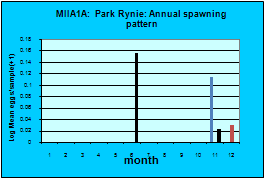Molidae: M II A1A
Ranzania laevis (Pennant, 1776)
Trunkfish




|
Egg diameter in µm |
Number of oil globules |
Diameter of oil globule in µm |
Yolk texture |
Perivitelline space |
Position of oil globule at hatch |
Gut length at eye- pigment stage |
Myomeres |
|
1370-1560 |
multiple |
NA |
clear |
narrow |
stern |
57% of NL |
18 |
.
Egg: The early egg of this species is easily confused with Sarda (MIIA2) due to size and the even spread of light amber oil globules. But as soon as the dark pigment appears (A), the two can be confidently separated. The interconnected patches of dark pigment on the yolk, are unusual (A & B). One of the eggs took 5 days to hatch (25°C), and it already had a visible embryo when collected (Plate B). For an egg this size, development is slow. Lyczkowski-Shulz (2006) gives an incubation of 7-8 days for Molidae, but does not specify the species.
Larva: The newly hatched larva looks like many early stage boxfishes and puffers (Lyczkowski-Shulz 2006, from Leis 1977), but the 3-day larva develops 3-pronged spines on the head and behind the pectoral fins (C & C1), which provide positive identification.
Three larvae hatched from this egg, have been barcoded, and match the barcode of a single adult found stranded in a rockpool at Scottburgh (BOLD). Curiously I have not found the eggs of the giant Mola mola off Park Rynie, although adults are frequently seen from skiboats operating in the area.

This egg had previously only been seen on 3 occasions off Park Rynie, twice in November 1999 and once in December 2000, but was seen 3 times in 2011 and 4 times in May and June 2012. Thirteen of the 17 eggs (76%) were in offshore samples.